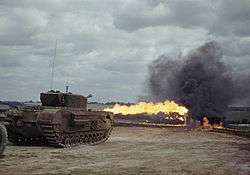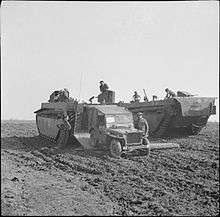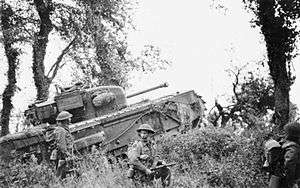31st Armoured Brigade
| 31st Armoured Brigade | |
|---|---|
|
A Churchill tank of 7th Royal Tank Regiment, 31st Tank Brigade, supporting infantry of 8th Battalion, Royal Scots, during Operation Epsom, 28 June 1944 | |
| Active | 1941–1945 |
| Country | United Kingdom |
| Branch | British Army |
| Type | Armoured brigade |
| Role |
Infantry support Mechanized infantry |
| Engagements | Western Front (1944–45) |
| Battle honours |
Odon Caen[1] |
| Insignia | |
| Identification symbol | Green on green diabolo[2] |
The 31st Armoured Brigade was an armoured brigade formation of the British Army, created during World War II.
Unit history
The unit was formed in the UK on 15 January 1941 as the 31st Army Tank Brigade, in Northern Command,[2] and initially comprised the 9th and 10th Royal Tank Regiments. The 141st Regiment Royal Armoured Corps was added on 8 November 1941,[3] and on 29 November it was transferred to South Eastern Command.[2]
In May 1942 the unit was redesignated the 31st Tank Brigade,[2] and was transferred to the 53rd (Welsh) Infantry Division, as part as a experimental "mixed" formation of a tank and two infantry brigades.[4] However, the experiment was abandoned on 10 September 1943, as judged unsuitable for the terrain in north-western Europe.[5] During this time, on 1 April 1943, the 10th RTR was renamed 7th Royal Tank Regiment, after the original unit of that name that was destroyed at the Battle of Gazala in May–June 1942.[2]
31st Tank Brigade first saw action as a follow-up unit in the Normandy landings, arriving in northern France on 19 June 1944, equipped with Churchill tanks, and supporting 15th (Scottish) Infantry Division until the end of July[2] in operations to capture the town of Caen.

141st Regiment RAC had been detached from the brigade on 21 June, to re-equip with the Churchill Crocodile flame-throwing tank, and it was also decided to convert the entire brigade to the "Crocodile".[2] 7th RTR was detached from the brigade on 17 August 1944, and was briefly replaced by 144th Regiment Royal Armoured Corps on the 23rd. Both the 144th RAC and 9 RTR were detached on 31 August, and on 4 September the brigade was transferred to the 79th Armoured Division, where it was rejoined by 141st Regiment RAC, and was brought back up to strength with the addition of 11th Royal Tank Regiment and the 1st Battalion, Fife and Forfar Yeomanry on 2 November.[2] 11th RTR was detached on 22 December, and replaced by the 49th Armoured Personnel Carrier Regiment and the 1st Canadian Armoured Personnel Carrier Regiment,[2] both equipped with the "Kangaroo", an obsolete tank with its gun turret removed, converted into a primitive armoured personnel carrier.

On 2 February 1945 the unit was again redesignated as the 31st Armored Brigade,[6] The 7th RTR, now equipped with Crocodiles,[7] returned on 14 February, and the brigade, as part of 79th Armoured, played its part in the crossing of the Rhine on 24 March. On 15 April, as the Allies advanced further into Germany, the LVT Buffaloes of the 4th Royal Tank Regiment (formerly the 144th Regiment Royal Armoured Corps) was added to the brigade, and it was also briefly further augmented by the addition of the Sherman DD tanks of the Staffordshire Yeomanry between 18 and 28 April.[2]
On 8 May 1945, V-E Day, Germany finally surrendered. A week later the brigade lost the 1st Canadian APC Regiment. The Fife and Forfar Yeomanry were detached on 6 June, and were replaced by the Royal Scots Greys.[2] As part of the occupation forces of the British Army of the Rhine, 31st Brigade was then slowly disbanded, first losing 4th RTR on 9 June 1945, then 49th APC on 1 July, 7th RTR on 23 August, and 141st Regiment RAC on 27 August. The 3rd Royal Tank Regiment joined on 28 August, but on 31 August they and the Greys were detached from 31st Armoured Brigade, bringing an end to the formation.[2]
Order of battle
| Unit | From | To |
|---|---|---|
| 9th Royal Tank Regiment | 15 January 1941 | 31 August 1944 |
| 10th Royal Tank Regiment (renamed 7th Royal Tank Regiment, 22 February 1943) | 15 January 1941 | 17 August 1944 |
| 14 February 1945 | 31 August 1945 | |
| 141st Regiment Royal Armoured Corps | 8 November 1941 | 21 June 1944 |
| 4 September 1944 | 27 August 1945 | |
| 144th Regiment Royal Armoured Corps | 23 August 1944 | 31 August 1944 |
| 1st Battalion, Fife and Forfar Yeomanry | 2 November 1944 | 6 June 1945 |
| 11th Royal Tank Regiment | 2 November 1944 | 22 December 1944 |
| 49th Armoured Personnel Carrier Regiment | 22 December 1944 | 1 July 1945 |
| 1st Canadian Armoured Personnel Carrier Regiment | 22 December 1944 | 15 May 1945 |
| 4th Royal Tank Regiment (formerly 144th Regiment Royal Armoured Corps until 1 March 1945) | 15 April 1945 | 9 June 1945 |
| Staffordshire Yeomanry | 18 April 1945 | 28 April 1945 |
| Royal Scots Greys | 6 June 1945 | 31 August 1945 |
| 3rd Royal Tank Regiment | 28 August 1945 | 31 August 1945 |
Commanding officers
The following officers commanded 31st Brigade:[2][8]
- Brigadier T. D. Murray (15 January 1941 – 1 March 1941)
- Brigadier T. R. Price (1 March 1941 – 24 August 1942)
- Brigadier G. S. Knight (24 August 1942 – 18 April 1945)
- Brigadier A. W. Brown (18 April 1945 – 31 August 1945)
See also
References
- Notes
- ↑ "31 Army Tank Brigade: Unit Honours". Orders of Battle Military Unit Database. Retrieved 30 November 2016.
- 1 2 3 4 5 6 7 8 9 10 11 12 13 "9th Royal Tank Regiment". The Royal Tank Regiment Association. Retrieved 30 November 2016.
- 1 2 "Organization of British Tank Brigades 1939–1945" (PDF). Combined Arms Research Library. U.S. Army. Retrieved 30 November 2016.
- ↑ Barclay (1956), p. 47.
- ↑ Barclay (1956), p. 52.
- 1 2 "Organization of British Armored Brigades 1939–1945" (PDF). Combined Arms Research Library. U.S. Army. Retrieved 30 November 2016.
- ↑ New, Laurence. "1943–1947". The History of the 4th and 7th Royal Tank Regiments. Retrieved 30 November 2016.
- ↑ "31 Armoured Brigade: Officer Commanding". Orders of Battle Military Unit Database. Retrieved 30 November 2016.
- Bibliography
- Barclay, C. N. (1956). The History of the 53rd (Welsh) Division in the Second World War. London, UK: Wm. Clowes & Sons. OCLC 36762829.
